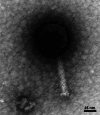Aerosolic Application of Phages Against S. infantis on Plates and Chicken Skin
- PMID: 39372362
- PMCID: PMC11447383
- DOI: 10.1089/phage.2023.0037
Aerosolic Application of Phages Against S. infantis on Plates and Chicken Skin
Abstract
Phages are known as a promising method to combat antimicrobial resistance (AMR) in the human and veterinary sector. Use of phage aerosols enormously increases the application field, although the impact on the infectivity of phages during nebulization needs to be evaluated. In this study S. infantis was treated on plates and chicken skin with nebulized phage particles of the Myoviridae type, identified by transmission electron microscopy, using a commercial nebulizer primarily used for H2O2 disinfection. The reduction of bacterial number by aerosol applied phage particles was evaluated. It could clearly be shown that the phage particles were able to infect Salmonella after being nebulized using ultrasound technology. Further studies on other types of phages as well as other conditions must be performed to standardize the aerosolic application of phages.
Keywords: AMR; Myoviridae; S. infantis; aerosol; nebulization.
Copyright 2024, Mary Ann Liebert, Inc., publishers.
Figures


References
LinkOut - more resources
Full Text Sources
